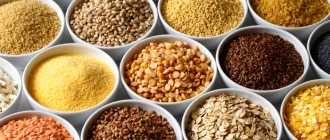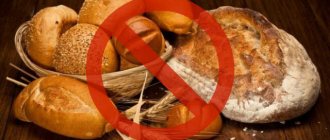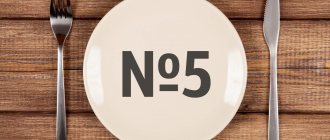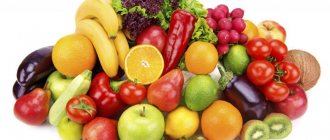The diet developed by Michel Montignac does not encourage you to starve. You can eat delicious, healthy meals while losing extra pounds every day. And in a couple of months you will admire your photographs and reflection in the mirror.
Michel Montignac, a Frenchman by birth, suffered from excess weight since childhood; this illness accompanied all family members in the male line. After graduating from university, Michel began to take a serious interest in pharmacology and tried many diets and medications to overcome excess weight. However, there was no result in his attempts.
At this time, the works of the American scientist in the fight against diabetes, Felicia Crapo, became popular. Based on her work, Montignac developed a nutritional system that is suitable for everyone, allowing you to eat all foods and still lose weight. Montignac wrote more than 20 books about his method and conducted a lot of research, and his book “I eat, therefore I lose weight: for everyone, everyone, everyone...” became a world bestseller!
The essence of the diet
Unlike other diets with strict time frames and food intake restrictions, the Montignac method offers nutrition balanced by the chemical and biological properties of foods. Regulating proteins, fats, and carbohydrates in food speeds up metabolism, reduces weight, reducing the risk of vascular diseases and diabetes.
When processing “bad” carbohydrates, excess glucose causes the body to increase insulin production, weakening the effect of pancreatic lipase on the breakdown of fats and causing the accumulation of excess weight. When digesting foods with low sugar content, a small amount of glucose formed in the blood does not disrupt the functioning of the pancreas.
The essence of the method is to separate carbohydrates, fats and proteins during each meal. To lose weight and improve the health of the body, eat foods with a glycemic index (GI) below 55, excluding foods with an index greater than 70, which increases the risk of developing diabetes.
IMPORTANT! Transferring patients with pancreatic diseases, diabetes and vascular pathologies to the Montignac diet improves the patients' condition by 45-65%!
Pros and positive results of losing weight
Following the rules of this nutrition system and the glycemic index table helps to achieve positive results in 2-3 months .
The undoubted advantages of such nutrition are that:
- First of all, the metabolism in the body is normalized.
- The diet does not require salt restrictions.
- It is permissible to eat everything that a person is accustomed to, even baked goods and sweets - it is important not to abuse this.
- All permitted products have high nutritional value.
- During this food system, a person has practically no feeling of hunger.
- During the diet, the body is saturated with a large amount of vitamins and microelements.
- The choice of products is wide; a person can create his own diet from the most preferred food.
In addition, followers of this diet retain their accumulated muscle mass. The table of healthy foods included with Michel Montignac's diet is very extensive, so the French nutritionist's nutritional system is easier to follow than classic diets.
This diet is especially suitable for women with a pear-shaped body.
The results of Michel Montignac's dietary nutrition system are clearly shown in the photographs below:


General menu requirements
1. Eating fatty and carbohydrate foods at different times, with a break of 2 to 4 hours. 2. Introduction of a three-meal regimen, abolition of any fasting. 3. Refusal to consume sugar and products containing it. 4. Canceling the consumption of white bread, if impossible, replacing it with bran bread. 5. Elimination of drinking coffee, black tea, alcohol, switching to drinking vegetable juices without sugar and fruit teas and infusions. 6. Removing vegetables and fruits with a high starch content from the menu. 7. Refusal of appetite-inducing seasonings. 8. Daily consumption of 2 to 3 liters of pure water.
IMPORTANT! Compliance with the requirements for two months helps to change your diet, normalize your metabolism and reduce your body weight by 15-20 kg!
Who is Michel Montignac?
The author of the innovative weight loss method was born in 1944 in France and already in childhood he was faced with the problem of excess weight. Little Michel inherited it from his far from thin father and as a result of unhealthy eating habits.
At first, the young man had no idea of devoting his life to dietetics. Studying at the institute at the Faculty of Social Sciences and Political Science, a diploma in pharmacology, working in a managerial position in a prestigious company... and still gaining weight. Fortunately, Michel's line of work had access to the latest medical research in the field of nutrition. And the education received was enough to not only take them into account, but also to develop, based on the learned data, my own method of losing weight.
First of all, the author tested it on himself, getting rid of 15 extra kilos in three months. And then, having become convinced of the effectiveness of the system, he began to promote it to the masses. Montignac's books, which sold like hot cakes, provided him with a reliable financial platform, allowing him to assemble his own team of scientists for a more thorough study of the invented methodology. As a result, each subsequent edition was supported by more and more serious scientific research and practical advice. This, by the way, explains some of the discrepancies in the menus and tables that were published at different times - while refining and improving the methodology, Montignac made the necessary changes.

Michel Montignac - French nutritionist and author of an innovative weight loss technique
Rules for using the diet
The diet is divided into two stages:
- Cleansing the body in parallel with weight loss. The duration of the stage is determined by the presence of excess body weight and the feeling of personal comfort at the end of the stage. The recommended combination of proteins, fats and carbohydrates when consuming foods with a GI below 50 reduces the release of insulin into the blood and prevents the “depositing” of new reserves. The consequence of this is an increase of 25-45% in energy costs for food processing, which helps burn previously accumulated fat.
- Consolidation of achieved results. After consolidating the diet and stabilizing weight, periodic consumption of foods with an increased index is allowed while monitoring health status. Maintaining a healthy diet throughout your life prolongs longevity.
IMPORTANT! Preliminary medical consultations protect against complications when using the diet!
What to do in case of a breakdown
Changing eating habits is not easy for most people who lose weight. Disruptions, judging by the reviews, sometimes happen.
If an unpleasant situation arises, the following rules should be followed:
- at the first breakdown, try to gain willpower and continue eating according to the system;
- if you want to eat a prohibited product, drink water;
- If the situation occurs again, take a break for 2 days, then return to the diet.
If you can’t stick to the nutrition system, you should give it up.
Glycemic index
The amount of glucose that enters the bloodstream after food is digested is called the glycemic index (GI), or body glycemia. Regardless of the time of consumption of carbohydrate products and the composition of carbohydrates, the peak value of blood sugar is established 20-40 minutes after eating.
Weight gain by the body is determined by the amount of insulin obtained from the digestion of glucose. The higher it is, the greater the risk of weight gain. An increase in blood glucose occurs after consuming a product with a high GI, for example: honey. A slight increase in glycemia is caused by the consumption of green vegetables, a product with a low index.
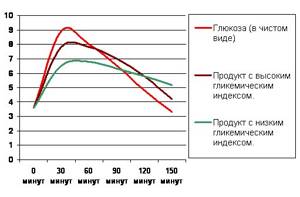
Glucose has the extremely high glycemic index in the line of carbohydrate products - 100 units. Minimum values of 15 units. have soy, tomatoes and mushrooms. All protein foods have “zero” or minimal index values.
Glycemia of the same product can vary and depends on:
- on the degree of grinding of the product (grinding, crushing, slicing);
- on the type of temperature treatment (quick frying, stewing, poaching);
- on the completeness of ripening (vegetables, fruits);
- on the grade, origin and type of product (the entire range of products).
IMPORTANT! When choosing products for the Montignac diet, taking into account the indicated indices, it is necessary to take into account the possibility of changing their values!
What results can you achieve in a month of diet?
A diet according to the glycemic index allows you to lose weight for a long time, provided that all points are followed. At the initial stage, weight loss will be from 1.5 to 2.5 kg per week.
At the middle stage, weight loss will already be from 0.7 to 1.5 kg per week.
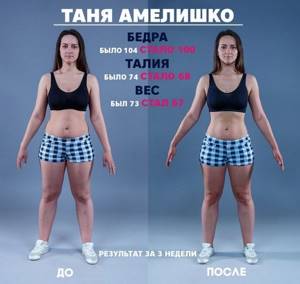
Depending on the body’s metabolism and how often foods with an average GI were consumed, at the middle stage, weight loss in a month can be 5-7 kg, in 3 months up to 15-16 kg.
Product selection rule
For the convenience of developing an individual nutrition plan according to the Montignac diet, a list of popular products has been compiled with the calculated glycemic index value for each item. Using this data, it is easy to create an individual diet based on its maximum healthfulness and taste preferences.
List of food products with glycemic index designation
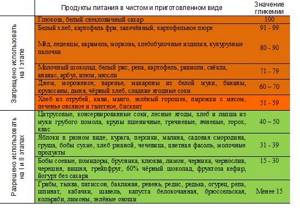
Here you can download the Table in .doc format
Doctors' opinion about the nutrition system
To paraphrase a well-known saying, let's say this: as many doctors, as many opinions. Among medical nutritionists there are both those who themselves recommend the Montignac diet to their patients and its fierce opponents. The main arguments of the latter:
- it is not perfectly balanced, so your body will not receive enough important substances;
- it does not take into account calories and portion sizes;
- it is high in protein, which is not entirely good;
- many are outraged by the complete ban on natural sweets (honey and sugar) and the abundance of artificial sweeteners in dietary recipes;
- The influence of the glycemic index on digestion is not a generally accepted fact. Some nutritionists believe that Montignac's research has not yet put an end to this issue.
For the most part, doctors have nothing against the patient studying the diet and gaining useful ideas for himself, but at the same time adhering to them without fanaticism. And consulting a doctor will never be superfluous - at least a local therapist.
Rules of the first stage of the Montignac diet
A prerequisite for the first stage is the consumption of foods with a GI of no more than 53 units. It is recommended to introduce mushrooms, seafood, fish, meat, salads with olive oil into the diet, replacing butter, margarine and carbohydrates with fruits and vegetables.
The fiber in fresh fruits actively reduces blood sugar. The consumption of pasta and bread made from low-grade flour with bran is encouraged. Coffee, sweet drinks and alcohol are prohibited.
The end point for the end of stage 1 is weight stabilization and adherence to a diet; the duration can last from 2 to 10 months.
Weekly menu of stage I
Based on the recommended products, a sample menu for the week is drawn up, which must be strictly adhered to:
Monday
- Breakfast: fruit juice without sugar, weak black coffee, bun.
- Lunch: White wine, vegetable salad with olive oil dressing, red meat entrecote with green vegetables, berry tea.
- Dinner: vegetable soup with vegetable oil, mushroom omelet, cottage cheese 1% fat, clean water.
Tuesday
- Breakfast: scrambled eggs and bacon, orange juice, coffee with milk.
- Lunch: red vegetable salad, grilled sea fish, cheese, mineral water.
- Dinner: kohlrabi cabbage with cheese, vegetable salad, sugar-free yogurt.
Wednesday
- Breakfast: cottage cheese 1% fat, toast with butter, weak coffee.
- Lunch: boiled beef in tomato sauce, fish appetizer, herbal tea.
- Dinner: green borscht, bacon, low-calorie yogurt, purified water.
Thursday
- Breakfast: omelet with sausages, fruit, porridge with water, rye toast, green tea.
- Lunch: boiled meat, vegetable salad with olive oil, biscuit, weak coffee.
- Dinner: vegetable soup, cabbage baked with cheese, low-fat cottage cheese, mineral water.
Friday
- Breakfast: fruit juice, second grade toast, coffee without sugar.
- Lunch: A glass of dry white wine, grilled sea fish with vegetable salad, mineral water.
- Dinner: lean pork with buckwheat, tomato salad, fruit tea.
Saturday
- Breakfast: 1% fat cottage cheese, wholemeal toast, vegetable juice or tea.
- Lunch: lean beef in tomato sauce, raw vegetables, mineral water.
- Dinner: Vegetable soup, boiled fish, green salad, juice without sugar.
Sunday
- Breakfast: white wholemeal bread, low-fat cottage cheese, weak coffee.
- Lunch: green bean and celery salad, boiled pork, fruit.
- Dinner: vegetable soup, boiled chicken breast, fruit tea.
What to include in your diet
The list of “good” carbohydrates is as follows:
- Bread made from wholemeal flour;
- Products with a small proportion of starch (beans and lentils);
- Naturally, you can find a wide range of vegetables and fruits on the list, but only those that contain a large amount of fiber and a low concentration of glucose (leeks, lettuce, green beans, turnips, and so on).
That is, it means excluding “negative” carbohydrates from the food consumed. “Positive” carbohydrates are less dangerous for the body and their consumption is possible only in small quantities.
It is imperative to adhere to the principle of separate nutrition, which involves not mixing “negative” carbohydrates with lipids. Lipids can be eggs, meat, or vegetable oil. It is worth considering that we are talking about one meal.
In addition, in the Montignac diet program there is such a rule as “Fruits first.” The rule is due to the fact that it is this food group that is most quickly absorbed, provided that a person consumes them on an empty stomach. Fruits are perfectly digestible and stimulate intestinal function.

As a result, they will enter the intestines within 15 minutes, thereby activating its work and preparing it for subsequent intake of food that is more problematic in terms of digestion.
Stage II diet
Maintaining a stable weight and improving the health of the body is the goal of the second stage, which can last as long as desired. It is allowed to periodically introduce dishes from potatoes, fats and carbohydrates into the stage I menu.
White, dry and semi-dry wines are allowed. The consumption of sugar, glucose, butter and white bread made from finely ground flour is prohibited. If necessary, to prevent and stop weight gain, you must adhere to the first stage diet for 2-3 days.
Contraindications
In order not to harm your health when using a diet, you need to know that the Montignac system is not suitable for everyone who wants to lose weight. It should be noted that it is prohibited during pregnancy and breastfeeding - a woman should eat without restrictions. Contraindications are:
- age up to 18 years – a balanced diet for children and adolescents is necessary;
- metabolic disorders, diabetes mellitus - the pattern of consumption of fats, proteins, carbohydrates can worsen metabolism;
- the presence of mental illnesses - dietary restrictions can cause their exacerbation.
The following factors are contraindications for the diet:
- The rehabilitation period after surgery and long-term illness requires a complete diet to restore strength.
- Old age - metabolic processes slow down, the nutritional system can worsen health.
- Gastritis, stomach ulcers, duodenal ulcers - a special gentle diet is necessary.
- Kidney failure - in case of illness, many of the products of the method are prohibited.
Cooking recipes
Chicken barley soup with vegetables
Required Products:
- 2.5 liters of water;
- 0.7-1.0 kg chicken fillet;
- an incomplete glass of pearl barley;
- 3 pcs. sliced yellow carrots;
- 3 pcs. chopped celery;
- 2 pcs. chopped onion
- 1 tbsp. l. olive oil;
- 2 chopped cloves of garlic;
- 1 PC. bay leaf;
- a third of a teaspoon of marjoram and rosemary;
- black pepper and salt as desired;
- fresh herbs;
- 1 spoon of lemon juice.
Preparation:
The pearl barley is soaked in water for 7-8 hours in the evening. Before boiling chicken fillet, it is necessary for 5 minutes. fry celery, onion, carrots, garlic in boiling oil. After frying, you need to bring the volume of the dish to 2 liters with hot water and add chopped chicken fillet. The washed barley, spices and salt are added to the boiling soup, the temperature is reduced - the dish is ready within 1 hour.
Pickled eggplants
The quantity of ingredients is not strictly specified. Before marinating, eggplants cut into rings are salted and infused for 30 minutes.
After rinsing the bitterness with water, the eggplants are again salted and quickly fried in vegetable oil. Cooled fried vegetables are laid out in layers in a tall bowl, alternating layers with chopped garlic, herbs and vinegar . After 1-2 hours, the dish can be eaten hot or cold.
Scrambled eggs with tomatoes and bell peppers
Required Products:
- 5-6 pcs. chicken eggs;
- 2-3 pcs. tomato;
- 1 PC. bell pepper;
- 4-5 chopped olives, herbs;
- 50 gr. vegetable oil.
Preparation:
Place tomatoes and bell peppers with the seeds removed in a single layer on heated oil in a frying pan. After 5-7 minutes. After stewing the vegetables, chicken eggs are added to the frying pan. Salt is added to the dish, as well as olives and fresh herbs after cooking.
Healthy recipes: tasty, fast, correct
Chicken breasts in yogurt
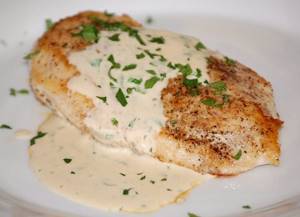
Just 15 minutes and you can have lunch
You will need:
- 500 g chicken breast fillet;
- 1–2 cups unsweetened yogurt;
- salt, pepper, herbs.
Preparation:
- Lightly beat the breasts.
- Sprinkle with salt, pepper, and your favorite seasonings.
- Place in a slightly greased form, fill with yogurt and place in the oven preheated to 180 degrees.
A quarter of an hour - and the protein-lipid lunch is ready.
Baked vegetables

A sea of vitamins and great taste
You will need:
- 2 eggplants;
- 2 bell peppers;
- 2 tomatoes;
- onions and garlic to taste;
- salt, pepper, spices.
Preparation:
- Wash the tomatoes, peppers and eggplants well, but do not peel them or remove the stems.
- Place the vegetables on the oven rack and bake for 45 minutes at 150 degrees.
- Take it out, let it cool a little and remove the peel, and also remove the seeds from the pepper.
- Cut the pulp into large pieces.
- Peel the onion and garlic and chop finely. Add to vegetables.
- Salt and season with spices.
A delicious carbohydrate dish will be useful for lunch or dinner.
Lentil cutlets

If desired, sesame seeds can be replaced with coconut flakes
You will need:
- 1 cup lentils;
- 50 g oatmeal;
- bulb;
- 1.5 tbsp. l. soy sauce;
- 1 tsp. apple cider vinegar;
- 2 tbsp. l. sesame seeds;
- 4–5 tbsp. l. ground bran;
- 0.5 tsp. ready seasoning for chicken.
Preparation:
- Boil the lentils until half cooked - 15–20 minutes. Drain the water and set the saucepan aside.
- Peel the onion and chop coarsely.
- Place it in a blender along with the cooled lentils and oatmeal.
- Add seasoning, sauce and vinegar.
- Grind everything and leave to sit for 20-30 minutes so that the oatmeal is soaked and swollen.
- Mix bran with sesame seeds.
- Form small cutlets from the lentil mass, roll them in bran and sesame seeds and place on a baking sheet lined with a sheet of foil.
- Bake in an oven preheated to 120 degrees for 20–30 minutes.
READ ALSO: HOW MUCH DENTAL TREATMENT COSTS
Craving a carb-heavy dinner? He's in front of you!
Video: Chocolate covered fruits for dessert
https://youtube.com/watch?v=xDaY3HkwDgk
Advantages and disadvantages of the Montignac diet
Advantages:
- Acceleration of metabolism, normalization of the pancreas, weight loss and stabilization.
- Availability of products and ease of adherence to the diet.
- There is no ban on the use of table salt.
Flaws:
- The need to take vitamin and mineral complexes due to the limited supply of essential substances from food.
- Avoiding a diet for diabetes.
- Long-term abstinence from alcohol, a long preparatory period for repeating the diet.
The main disadvantages of the French diet include:
- Its lack of balance.
- The need to constantly monitor the ratio between fats, proteins and carbohydrates.
- We have to constantly decide how to diversify our diet.
- Avoidance of alcoholic beverages is required.
- The diet requires a fairly long (about 2-3 months) adherence to achieve results.
- Difficulties associated with limiting fat if there is an increase in protein intake.
- Constant monitoring of the glycemic load so that it does not exceed the norm.
Despite the fact that the results of the Montignac diet are most often positive, this nutritional system is not recommended for people:
- Those suffering from mental illness.
- With impaired metabolism.
- Patients with diabetes mellitus.
- Pregnant women.
- During the recovery period after a long illness.
- During postoperative rehabilitation.
- Teenagers during puberty.
Reviews from people who have experienced this nutrition system themselves confirm that it really works. However, you should remember that the result will not be quick, you need to be patient. Losing weight on the Montignac diet is pleasant, because it even allows chocolate, which is strictly prohibited on many other diets.
Reviews from nutritionists and doctors
Margarita, 54 years old
As an endocrinologist, patients often come to me wanting to lose weight. People often ask about the Montignac method for weight loss. I think that the author paid too little attention to physical activity. They help activate metabolic processes and burn excess calories, which is important for losing weight.
Ekaterina, 48 years old
I have been working as a nutritionist for more than 15 years, and I have tried the Montignac system on myself. I recommend it to my patients because it does not require fasting. You can choose a diet that is balanced in nutrients. The main thing is that it is an easy way to achieve stabilization and maintenance of the required weight.

